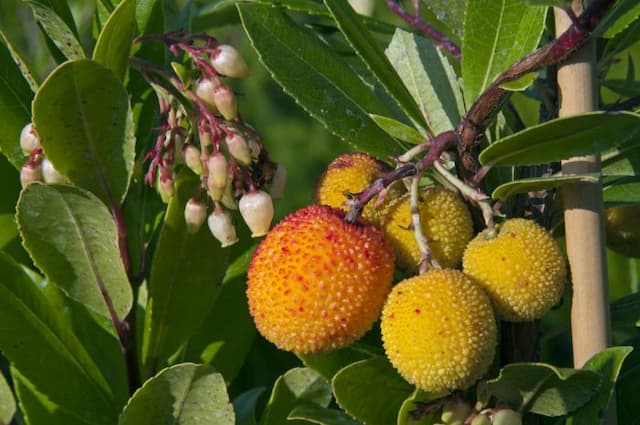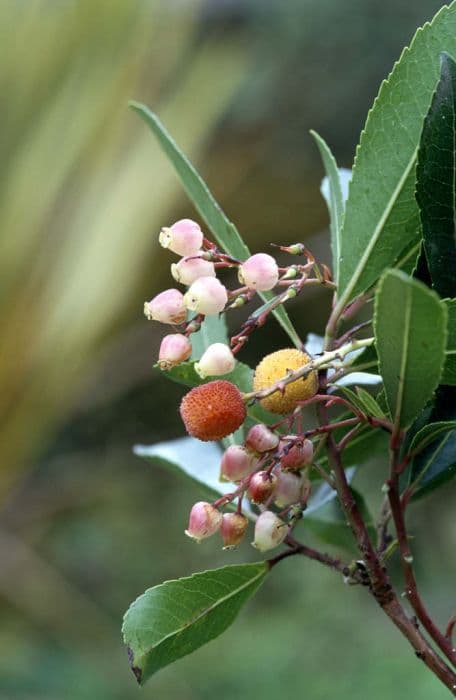Rhododendron Rhododendron 'Merganser'

ABOUT
The Rhododendron 'Merganser' is a flowering shrub that showcases an abundant display of blossoms. The flowers of this rhododendron are quite striking, typically exhibiting a vibrant color palette. Each flower cluster, known as an inflorescence, is composed of numerous individual blooms that contribute to a lush, rounded appearance. The petals are often a rich hue, ranging from pale pinks to deep purples, with the possibility of intricate patterns or markings that can include spotting or shading within the throat of the flower. The foliage of the 'Merganser' rhododendron is equally attractive, with leaves that lend a lush backdrop to the bright blossoms. The leaves are typically broad, glossy, and evergreen, providing year-round interest. They are arranged in a dense pattern along the branches, creating a full and robust look for the plant. When not in bloom, the rhododendron's foliage maintains a strong visual presence in the garden with its deep greens, contributing to its status as a staple in many ornamental landscapes. Overall, the 'Merganser' rhododendron is a plant that boasts beautiful floral displays that are sure to be a centerpiece in any garden when in bloom, while its attractive foliage keeps the plant interesting throughout the year.
About this plant
 Names
NamesSynonyms
Merganser Rhododendron
Common names
Rhododendron 'Merganser'.
 Toxicity
ToxicityTo humans
Rhododendron 'Merganser', commonly known as Rhododendron, is toxic to humans if ingested. All parts of the plant contain a group of toxic compounds known as grayanotoxins. Symptoms of poisoning can include a burning sensation in the mouth, excessive salivation, vomiting, diarrhea, low blood pressure, and muscle weakness. In severe cases, it can lead to cardiac failure and potentially coma. It is important not to consume any part of a Rhododendron plant.
To pets
Rhododendron, the common name for Rhododendron 'Merganser', is toxic to pets as well. Similar to humans, the plant's leaves, flowers, and nectar can cause poisoning due to the presence of grayanotoxins. Symptoms in pets may include drooling, vomiting, diarrhea, weakness, and depression of the central nervous system. In severe cases, it can lead to coma or fatal heart rhythm disturbances. Eating even a few leaves can cause serious problems, and immediate veterinary attention is recommended if ingestion is suspected.
 Characteristics
CharacteristicsLife cycle
Perennials
Foliage type
Evergreen
Color of leaves
Green
Flower color
Pink
Height
6 feet (1.8 meters)
Spread
6 feet (1.8 meters)
Plant type
Shrub
Hardiness zones
5
Native area
Asia
Benefits
 General Benefits
General Benefits- Ornamental Appeal: Rhododendron 'Merganser' offers striking flowers that enhance the aesthetic beauty of gardens and landscapes.
- Attracts Pollinators: The plant's flowers can attract important pollinators like bees, butterflies, and other beneficial insects, supporting local ecosystems.
- Versatility: This rhododendron can be used in a variety of landscape settings, including borders, woodland gardens, and as a specimen plant due to its shape and size.
- Shade Tolerance: It can thrive in partially shaded areas, where other sun-loving plants might not perform well.
- Seasonal Interest: Provides vibrant blooms in the spring and lush foliage throughout the growing season, offering multi-season interest in the garden.
- Low Maintenance: Once established, Rhododendron 'Merganser' generally requires minimal care, making it suitable for gardeners of all skill levels.
- Cold Hardy: It is adaptable to a range of climates and can withstand cold temperatures, making it a robust addition to gardens in many regions.
- Erosion Control: With its substantial root system, it can help stabilize slopes and areas prone to erosion.
 Medical Properties
Medical PropertiesThis plant is not used for medical purposes.
 Air-purifying Qualities
Air-purifying QualitiesThis plant is not specifically known for air purifying qualities.
 Other Uses
Other Uses- Natural Ink Source: The petals of the Rhododendron can be used to create a natural dye or ink, which can be used in artistic creations or for staining fabrics.
- Photography Subject: Rhododendrons are popular among photographers for their vibrant flowers and can be a great subject for practicing macro and nature photography.
- Culinary Garnish: The blossoms of some Rhododendron varieties are edible and can be used to add a floral garnish to desserts and drinks.
- Indicator Plant: Rhododendrons can serve as an indicator plant for gardeners, as their leaves droop when they are water-stressed, signaling possible drought conditions.
- Bonsai: The Rhododendron can be cultivated as a bonsai plant, providing a challenge for enthusiasts and a unique way to display the plant's beauty.
- Habitat Support: The dense foliage provides shelter for small wildlife, supporting local biodiversity in a garden setting.
- Art Medium: Leaves and petals of the Rhododendron can be used in pressed flower art or to create natural patterns in various craft projects.
- Wedding Decor: Their bright and attractive flowers can be used in floral arrangements or as part of wedding bouquets and venue decorations.
- Botanical Studies: Rhododendron varieties provide a rich subject matter for botanical studies and plant sciences, especially in areas concerning hybridization and growth habits.
- Living Fences: Rhododendrons can be grown as hedges or living fences, offering privacy and reducing noise when planted in masses.
Interesting Facts
 Feng Shui
Feng ShuiThe Rhododendron is not used in Feng Shui practice.
 Zodiac Sign Compitability
Zodiac Sign CompitabilityThe Rhododendron is not used in astrology practice.
 Plant Symbolism
Plant Symbolism- Beware: Rhododendrons can be toxic if ingested, which gives them a meaning of caution or danger.
- Elegance: With their lush, vibrant blooms, rhododendrons are often associated with beauty and elegance in the plant world.
- Abundance: The full, abundant clusters of flowers that characterize rhododendrons symbolize an overflow of wealth or prosperity.
- Homecoming: In certain cultures, the rhododendron is a symbol of homecoming or a warm welcome, perhaps due to its hearty and resilient nature.
- Endurance: As a plant that can thrive in challenging conditions, rhododendrons represent the ability to persevere and endure.
 Water
WaterThe Rhododendron, commonly known as azalea, should be watered thoroughly when the top inch of soil feels dry to the touch. Typically, this would be about once a week, but frequency can vary depending on climate and weather conditions. Use a gentle stream of water to soak the soil around the plant until it's evenly moist, not waterlogged. During the growing season, azaleas may require up to 1 gallon of water per plant each week, but always adjust based on rainfall and temperature. In winter, reduce watering as the plant's water needs decrease.
 Light
LightAzaleas thrive in spots with dappled sunlight or partial shade. They should be protected from harsh afternoon sun which can burn their delicate leaves. The best location for an azalea is a spot where it can receive morning light and shade during the hottest part of the day, ensuring bright but indirect light conditions.
 Temperature
TemperatureAzaleas do best in temperatures ranging between 60°F and 80°F, which are considered ideal for their growth. They can survive minimum temperatures down to about 20°F, but long-term exposure to cold below this range can be damaging. Similarly, temperatures above 90°F can cause stress to the plant, so it's important to provide adequate shade during the extreme heat.
 Pruning
PruningAzaleas benefit from pruning to maintain shape, encourage bushiness, and remove dead or diseased wood. The best time to prune is just after the blooming period, as pruning too late can remove next year's flower buds. Light trimming can be done every year, while more extensive cuts should be made less frequently.
 Cleaning
CleaningAs needed
 Soil
SoilRhododendrons, including Rhododendron 'Merganser', require well-draining, acidic soil with a pH of 4.5 to 6.0. A good soil mix can be created with equal parts peat moss, pine bark, and perlite to ensure proper aeration and moisture retention. Regularly check soil pH to maintain acidic conditions optimal for rhododendron growth.
 Repotting
RepottingRhododendrons like the 'Merganser' generally need repotting every 2 to 3 years to ensure they don't become root-bound. It's best to repot them in spring before they begin their active growth cycle, using a soil mix designed for acid-loving plants.
 Humidity & Misting
Humidity & MistingRhododendrons, such as 'Merganser', thrive in moderate to high humidity levels, ideally between 40% to 60%. They benefit from a humid environment that mimics their natural habitat but be careful to avoid overly wet conditions that can promote disease.
 Suitable locations
Suitable locationsIndoor
Place in bright, indirect light with high humidity.
Outdoor
Partial shade with moist, acidic soil is ideal.
Hardiness zone
5-8 USDA
 Life cycle
Life cycleRhododendron 'Merganser' begins its life as a seed that requires well-drained, acidic soil with adequate moisture to germinate. Once germinated, the seedling grows into a young plant with tender leaves, which gradually matures into a sturdy shrub with a woody stem over the course of several years. The mature Rhododendron 'Merganser' produces buds in late winter to early spring, which then bloom into colorful flowers typically in the spring. After pollination, often by insects, the flowers develop into seed pods that ripen and release seeds to propagate the next generation. Throughout its life cycle, this Rhododendron requires careful maintenance, including protection from harsh sun, regular watering, and pruning to encourage healthy growth and blooming. The plant can live many decades, with some specimens reaching a significant size and becoming prominent features in gardens and landscapes.
 Propogation
PropogationPropogation time
Spring-Early Summer
Rhododendrons, including the Rhododendron 'Merganser', are commonly propagated by semi-hardwood cuttings. This process involves taking cuttings from new growth that has started to mature but is not yet hard; this is often in late summer. The ideal length for these cuttings is about 4 to 6 inches (10 to 15 centimeters). Leaves on the lower half of the cutting are removed, and the base is dipped in a rooting hormone to encourage root growth. The cutting is then planted in a mixture of peat and perlite or a similar rooting medium, and kept under high humidity and indirect light until roots develop. After rooting, which typically takes several weeks to a few months, the new plants are gradually acclimated to less humid conditions before being transplanted outdoors.









